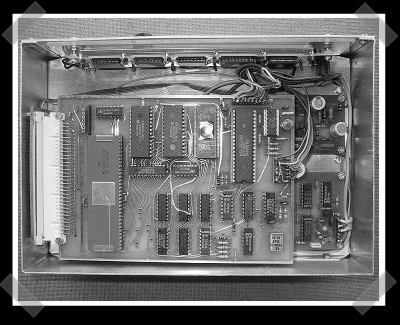
[superlopez] sent in this detailed article (mirrored here and here) which describes how to build a GPS and GLONASS (the Russian version of GPS) receiver. The resulting device is gigantic compared to one of those tiny bluetooth USB GPS units, but the ability to build one’s own receiver is one of those post-apocalyptic skills I sure would like to have. The creator of the article [Matjaz Vidmar] aka [S53MV] also has pages on Packet-Radio (PKT) transceiver improvements (PKT gets my vote for the best post-apocalyptic technology, and the only believable technology featured in the Transformers movie), and a more sophisticated homemade frequency counter than the one featured earlier this summer.
In 2005 we featured a from-scratch GPS receiver as well, thought the project site seems to be down. If your GPS unit just needs a better antenna, check out [Will]’s how-to from last year.
















anybody have any links to any sites that describe how to make a packet radio transmitter/receiver? I found some sites that say you can use your sound card, but they weren’t really reliable.
Damn this guy is just waiting for an apocalypse to show he can still talk and find his way around.
F3
You all have plenty of time to build this. I won`t have the apocalypse ready for another month at least.
I think the reason we don’t see many self contained circuits being published on the Internet now days is we’ve all became lazy over the past decade.
For example if you go search for single board computers with NTSC or PAL output most of the designs stopped being published in the late 90’s. I guess that’s when the analogical tide broke and everyone signed contracts with big company’s that licensed there employees creativity as there own.
It’s cool to see more RF devices being made. It’d be even cooler to see something like 12Mhz shortwave digital packet protocols being implemented in non-commercial circuits. Even better would be AES or triple DES shortwave protocols.
As I understand it, many of the circuits aren’t published anymore because it’s usually accomplished via software. Sound cards are wonderful things, and as long as you connect it directly to your radio, you don’t need any additional, expensive components. It’s also more flexible.
One good example of this is Digital Radio Mondial. As far as I know, there are no DRM decoder chips, or at least none that are widely available. If you want to listen to DRM, you need to first mod your receiver to output 12kHz, then feed it into a computer and decode it there. Eventually it will be moved into hardware, but doing it in software is more flexible.
GPS in a post apocalypses?
Don’t count on it, these machine rely on frequent maintainance. Also its likely to be shut down during a apocalypses, by the American government to civilian applications.
Packet radio soulds pretty good… Packet Usenet anyone?
It’s not that we’re not being “creative” anymore, it’s that hobby single-board computing isn’t as fun as it used to be. You used to be able to make something only slightly slower than a commercial machine, and do useful computation on it. Nowadays you’re mostly stuck at the same level people were in the early 90’s/late 80’s (try breadboarding a 386!), which isn’t nearly as fun. That, and FPGA’s have removed the need to wirewrap 50 discrete IC’s (Verilog is WAY easier than wirewrapping!).
crackerjackel, that is why it is using both GPS and Glonass… If either the US or the Russians (or their satellites) survive, it will still be usable!!
lol
I have a USB dongle that gets pretty good MPEG over different satellite bands, but it doesn’t make me want to stop messing with AX.25 and obscure spectrum hardware.
Also FPGA’s are pricey as hell even on an engineers salary. Some of us stick to salvaging components as a necessity. In a post apocalyptic state the yuppies and the consumers would perish after going on parasitic rampages.
Seeing the hardware it looks like from 1970 or earlier… not a very modern approach.
Anyways, this guy really understands RF electronics.
I wouldn’t really call FPGA’s “pricey as hell” nowadays (certainly years ago). You can get a breadboard-able ~1 million gate Spartan3 with LED’s, switches, 32MB of SDRAM and an on-board flash chip for about $200 (http://xess.com/prod035.php3 – I have one, they’re great). No JTAG programmer or anything needed (just over parallel).
On the bright side, you can now design your own processor that can achieve ~20-50 MIPS, which was just about impossible even 10 years ago =)
Alexander- A transceiver suitable for telephony will work for packet. On consideration for packet would be it’s RX to TX turn around time. Because my old TNCs are still functioning, I have yet to use a compter/sound card with the AGWPE utility program. Those I know who do haven’t mentioned any problems other than it may take a bit of futzing to get all the components to like each other.
Sean- While software is playing a larger role, we still need the RF circuitry for the software to have something to do.
Post-apocalyptic? Chances are the first radio comms. will be by CW operators using Morse Code. I’m no Morse Code forever type, but CW equipment is simple and can do more with less power than any other wireless mode. Even it requires the most powerful computer yet, the human brain.
This is from 1991, when commercial GPS receivers cost $1000s. Very nicely done!
bluetooth gps receiver doesn’t seem that expensive now, right? :)
Bring it to the people, alexander!
CW FTW!
(73 DE N2NLQ!)
are bhosdiwalo kuch DOWNLOAD section to rakho isme.
sirf ise dekhkar kya lauda hilayenge
Aaaaaaaaaaaaaaaaaa!!!!
Matjaz Vidmar was my professor at the faculty!
He is a GENIUS. Period.
I saw those plans 20 years ago! Can you imagine a GPS receiver at that time?!